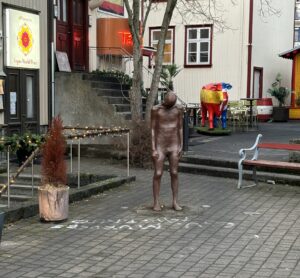There are so many things to see while in the city center of Reykjavik, and as you may have read in one of my classmates’ blogs we’ve been exploring the idea of “who is this here for?”. Is it for residents? Or is this here for tourists? There are shops and restaurants that are clearly geared toward tourists (usually the puffins are a dead giveaway). However, what I invite you to think about, as I share images of graffiti and the stories behind them, is the fact that these are also geared towards tourists.
Let’s first reflect on the places these writings were found and the language they are in. The placement of the writings in popular tourist areas is no doubt intentional, likely aimed to encourage people to look deeper into the stories behind them.
Another key aspect is the fact they are written in English. As we have read about (and observed while here) Icelanders tend to converse and write in Icelandic whenever the audience is fellow Icelanders. English seems to be the default language when it comes to all things tourist in Reykjavik from menus, advertisements, and even the names of stores. So the use of English in these instances to speak directly to the tourist audience hopefully encourages people to inquire into the bigger story.
Beginning by diving into the first image of writing in front of a statue I spotted outside the restaurant Vegan World Peace, across the street from the Center of Reykjavik marker, and most notably less than a 5-minute walk from Alþingishúsið (Parliament House).

What are your initial reactions to reading a statement of this magnitude?
When we came across this on our first day, I was taken aback and turned to some of the other students with me to see if they had noticed. Once it was pointed out to them, they shared a similar initial reaction of shock and curiosity. This curiosity was furthered by hearing other students had encountered graffiti referencing migrants near Hallgrimskirkja (as seen in Cole LaPlante’s blog). I then began to dig and look around various news sources. Primarily the Reykjavík Grapevine, Iceland Review, and Visir. Based on what I found, this appears to reference not one distinct event in Iceland, but rather a larger commentary on Iceland and the E.U.’s actions regarding deportations of migrants. One instance is the deportation of 180 Venezuelans this November after being denied asylum. This is a result of stricter legislation passed this past spring, legislation that has created concerns regarding “increased rates of homelessness”.
Overall, the statement “E.U. Murdered Migrants” appears to be less specific (which could just be that I was unable to find any reports regarding a specific incident) than the next image I’ll show you. In my opinion, it shares the same goals: To grab attention, raise awareness, and provoke conversation.
While this next image echoes the goals I mentioned and also utilizes English and a high-traffic space in the city center (directly across from Aðalstræti 10 and the Reykjavik city museum, it’s also a direct response to something that occurred in Iceland.

The story of the 3 women who were evicted does include mentions of human trafficking, if you wish to avoid this content please skip the next 2 paragraphs.
In August of 2023, a group of asylum seekers were evicted after having their asylum applications rejected. It had been 30 days since the rejection had passed, and in line with the new legislation, unless they agreed to voluntarily return to their home country or place they hold a residence permit, they are then denied essential services and find themselves at risk of homelessness. One woman’s story generated media coverage and created an interesting conversation regarding the Icelandic government’s actions in regard to asylum seekers.
Blessing Newton is one of the three women evicted, and from what I understand, while hers is the only public story, all three were victims of sex trafficking in Italy after fleeing there from Nigeria. Blessing was offered a job in child care in Italy in 2016 and was then held against her will. Eventually, after a few years of various abuse, and living on the streets of Italy, she ended up in Iceland where she applied for “international protection on humanitarian grounds”. Her application was denied. As it currently stands, even though Blessing’s lawyer states despite living in Iceland for 2 years and meeting “all the conditions to be allowed to stay in Iceland” (Visir) she will likely be sent back to Italy …. the very place where she was sold, trafficked, and exploited.
Issues of asylum and deportation are not something you would normally think about as you walk down the streets of Reykjavik filled with puffin shops on the way to your hotel, Airbnb, or hostel. All accommodations where you will likely be met by employees of a largely immigrant workforce, as “Iceland has started importing foreign labor while at the same time refusing to give employment permits to asylum seekers”(IDN). Truly the stories of these migrants and organizations that are standing with them against this new legislation are something I never would have encountered had I not seen the graffiti while out and about exploring an area certainly geared towards tourists.
So I ask you to once again consider who is this here for? Is it for a tourist in the hopes they follow a path similar to mine and inquire for more information? Is it for the parliament members and employees who work in the area? Can it be for both?
As you ponder this I also encourage you to read more about Iceland’s newer legislation and check out Solaris (an aid organization for refugees and asylum seekers in Iceland).